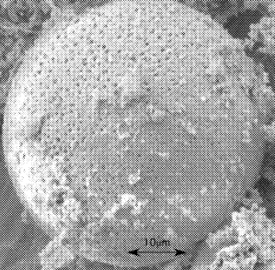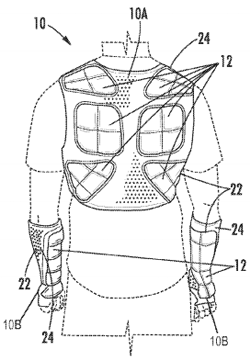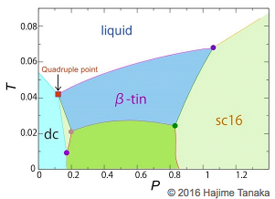 The Phase Change Matters e-mail newsletter is a weekly summary of the latest news and research on phase change materials and thermal energy storage. To subscribe, visit www.puretemp.com/subscribe. For more frequent updates, follow @puretemp on Twitter or visit the Phase Change Matters blog, www.puretemp.com/pcmatters.
The Phase Change Matters e-mail newsletter is a weekly summary of the latest news and research on phase change materials and thermal energy storage. To subscribe, visit www.puretemp.com/subscribe. For more frequent updates, follow @puretemp on Twitter or visit the Phase Change Matters blog, www.puretemp.com/pcmatters.
PATENTS
Latent heat transfer material micro-encapsulated in hard shell
U.S. patent application 20160251557 (applicant Kobe University, Japan):
 “Provided is a latent heat transfer material that is micro-encapsulated, said material exhibiting superior mechanical strength and heat resistance. A production method for the latent heat transfer material that is micro-encapsulated in a hard shell comprises: 1) a step in which a perforate hollow silica particle is manufactured; 2) a step in which the phase change material is sealed inside the perforate hollow silica particle by inserting the perforate hollow silica particle in a molten solution of the phase change material and repeatedly subjecting the same to vibrations such as ultrasound oscillations; 3) a step in which the perforate hollow silica particle having the phase change material sealed within is washed in a saturated aqueous solution of the phase change material; and 4) a step in which perhydropolysilazane is used to coat the outer shell of the perforate hollow silica particle with silica.”
“Provided is a latent heat transfer material that is micro-encapsulated, said material exhibiting superior mechanical strength and heat resistance. A production method for the latent heat transfer material that is micro-encapsulated in a hard shell comprises: 1) a step in which a perforate hollow silica particle is manufactured; 2) a step in which the phase change material is sealed inside the perforate hollow silica particle by inserting the perforate hollow silica particle in a molten solution of the phase change material and repeatedly subjecting the same to vibrations such as ultrasound oscillations; 3) a step in which the perforate hollow silica particle having the phase change material sealed within is washed in a saturated aqueous solution of the phase change material; and 4) a step in which perhydropolysilazane is used to coat the outer shell of the perforate hollow silica particle with silica.”
HVAC system for electric vehicle with driving range extension
U.S. patent application 20160250906 (applicant Mahle International GmbH, Germany):
“A heat pump cooling and heating system for an electric vehicle includes a range extending PCM heat exchanger, with a single acting phase change material with a melt temperature between the two comfort temperatures associated with cooling and heating, respectively. In a charging mode, as the vehicle batteries are charged, the same exterior current source runs the compressor, charging the PCM exchanger with heat or ‘cold.’ During an initial range extending mode, the PCM exchanger/reservoir serves as the heat source or heat sink. The PCM material does not directly heat or cool the air, as is conventional, allowing a single reservoir material to be used in both heating and cooling modes.”
Apparel article to pre-cool the body
U.S. patent application 20160249691 (applicant Adidas AG, Herzogenaurach, Germany):
“Described are articles of wear having a base layer, a plurality of cooling zones positioned on the base layer so that substantially all of the plurality of cooling zones are positioned adjacent regions of a wearer’s body having highly efficient heat transfer properties of a wearer when worn, and cooling material contained within the plurality of cooling zones. The article of wear is configured to reduce a wearer’s body heat content through heat transfer from each region having highly efficient heat transfer properties to each cooling zone when the cooling material is pre-cooled prior to wearing. … wherein the cooling material comprises a phase change material. “
Elastomer and/or composite based material for thermal energy storage
U.S. patent application 20160251558 (applicant Enrad Ltd., Moshav Shahar, Israel):
“A composite material for storing thermal energy at various temperatures (30° C. to 450° C.) formed by an elastomer matrix into which a phase change material such as an inorganic salt is encapsulated. The material is characterized by a high volumetric thermal conductivity, a low density, a highly interconnected porosity and a relatively high modulus of elasticity. The significant properties of the matrices are: a large amount of energy involved in full melting/crystallization, a fairly low relative volume expansion upon melting and fairly low sub-cooling. The main advantages of the resulting composites are a very high energy density, a relatively low volume expansion, highly enhanced heat transfer, thermo adaptability, stability and insignificant hysteresis.”
IN BRIEF
 • Croda has earned the U.S. Department of Agriculture‘s Certified Biobased Product label for all six of its CrodaTherm phase change materials. Third-party verification administered through the USDA’s BioPreferred Program is required to confirm a product’s biobased content. Croda and Entropy Solutions are the only PCM makers to qualify for the label. Eighteen of Entropy’s PureTemp PCMs, ranging from 4 to 68 degrees Celsius, are designated as 100 percent biobased.
• Croda has earned the U.S. Department of Agriculture‘s Certified Biobased Product label for all six of its CrodaTherm phase change materials. Third-party verification administered through the USDA’s BioPreferred Program is required to confirm a product’s biobased content. Croda and Entropy Solutions are the only PCM makers to qualify for the label. Eighteen of Entropy’s PureTemp PCMs, ranging from 4 to 68 degrees Celsius, are designated as 100 percent biobased.
• Refrigeration battery maker Axiom Exergy has posted openings for an electromechanical technician, a product engineer and a project manager at its facility in Richmond, Calif.
• Registration is open for the U.K.-focused Future Thermal Energy Conference at the University of Warwick, Coventry, England, Oct. 10-11. Topics include district heating networks, heat pumps, CHP, biomass and above- and below-ground thermal storage.
• Viking Cold Solutions of Houston introduced its hybrid cooling system at an industry conference in Australia this week. The system, which combines rooftop photovoltaic panels and PCM-based thermal energy storage, is designed to reduce energy costs at supermarkets and cold storage facilities.
• Phase Change Energy Solutions, BASF Education Lab and CALMAC are among the exhibitors scheduled to attend the Greenbuild conference and expo Oct. 5-7 in Los Angeles.
 • In research that appears to conflict with thermodynamic law, scientists at the University of Tokyo have run simulations showing that four phases of a substance can coexist at thermal equilibrium, where all parts are at the same temperature and pressure. The research “may prove useful in the development of functional phase change materials,” according to a university news release, “as it demonstrates that multiple phase transformation can be induced through weak disturbance (perturbation) near the quadruple point.”
• In research that appears to conflict with thermodynamic law, scientists at the University of Tokyo have run simulations showing that four phases of a substance can coexist at thermal equilibrium, where all parts are at the same temperature and pressure. The research “may prove useful in the development of functional phase change materials,” according to a university news release, “as it demonstrates that multiple phase transformation can be induced through weak disturbance (perturbation) near the quadruple point.”
• Emerson is expanding its cold chain presence with the acquisition of two temperature-monitoring companies: Locus Traxx of Jupiter, Fla., and PakSense of Boise, Idaho. Terms were not disclosed.
• Ravi Teja, an R&D associate specializing in phase change materials at Pluss Advanced Technologies in India, is a finalist for the Energy Institute‘s Young Energy Professional of the Year award.
• Entropy Solutions has posted a new technical paper on puretemp.com: “Characterization of microencapsulated PCMs using DSC and thermogravimetric analysis,” by Heather Watson, Ph.D., manager of analytical services.
• Pharmaceutical Commerce is projecting $12 billion in cold chain biopharma logistics spending worldwide in 2016: $9 billion in transportation and $3 billion in specialized instrumentation and packaging such as phase change materials. By 2020, cold-chain biopharma logistics spending is projected to top $16 billion.
RESEARCH ROUNDUP
For our full list of recent academic research, see puretemp.com/academic. Here are highlights from the past week:
From Applied Energy:• Encapsulation of phase change materials using rice-husk-char
From Applied Thermal Engineering:
• Performance study of an enhanced solar greenhouse combined with the phase change material using genetic algorithm optimization method
• Modelling and experimental study of low temperature energy storage reactor using cementitious material
• Inverse heat transfer prediction of the state of the brick wall of a melting furnace
From Thermochimica Acta:
• Silica-coated poly(glycidyl methacrylate-ethylene dimethacrylate) beads containing organic phase change materials
From Energy Conversion and Management:
• Fabrication and characterization of a new enhanced hybrid shell microPCM for thermal energy storage
• Numerical and experimental investigation on latent thermal energy storage system with spiral coil tube and paraffin/expanded graphite composite PCM
From Fibers and Polymers:
• Preparation of electrospun LA-PA/PET/Ag form-stable phase change composite fibers with improved thermal energy storage and retrieval rates via electrospinning and followed by UV irradiation photoreduction method
From Energy:
• A simplified model to study the location impact of latent thermal energy storage in building cooling heating and power system
From Solar Energy Materials and Solar Cells:
• Innovative synthesis of high performance poly(methyl methacrylate) microcapsules with encapsulated heat storage material by microsuspension iodine transfer polymerization
From International Journal of Refrigeration:
• Experimental evaluation of thermal properties of r134a clathrates based PCMs for cooling applications
NETWORKING
Connect with PCM experts and industry leaders on LinkedIn
More than 850 of your peers have joined a LinkedIn group devoted to the discussion of phase change material and thermal energy storage. The Phase Change Matters group is an interactive complement to the award-winning blog and newsletter of the same name.
You are invited to join the group and connect with PCM and TES experts from around the world. New members this week include Rui Costa Neto, senior project manager and energy researcher at Técnico Lisboa, University of Lisbon, Portugal; Daryl K. Hairston, project manager, DHLK Group, Los Angeles, Calif.; Alessandra Sanson, group leader, materials and processing for energetics, CNR-ISTEC, Italy; Amirreza Fateh, renewable energy analyst at ZAE Bayern, Germany; and Valeria Palomba, a Ph.D. student in materials engineering in Italy.
Amirreza writes: “I’m doing an internship on buildings integrated by PCM for increasing energy efficiency. As I am interested to continuing my research in this field, I would really appreciate if some body help me to find a job in this field.”
Valeria writes: “I am involved in research on phase change materials for solar applications, focusing especially on the simulation of the systems and the testing of prototypal storages.”